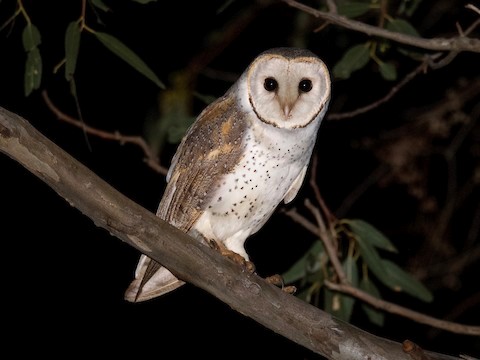Birdfinding.info ⇒ Widespread and fairly common in several portions of its extensive range, including large swaths of India and Australia and the main islands of Fiji and Samoa. Comparatively scarce or localized in Southeast Asia and Indonesia.
Eastern Barn Owl
Tyto javanica
South Asia to western Polynesia.
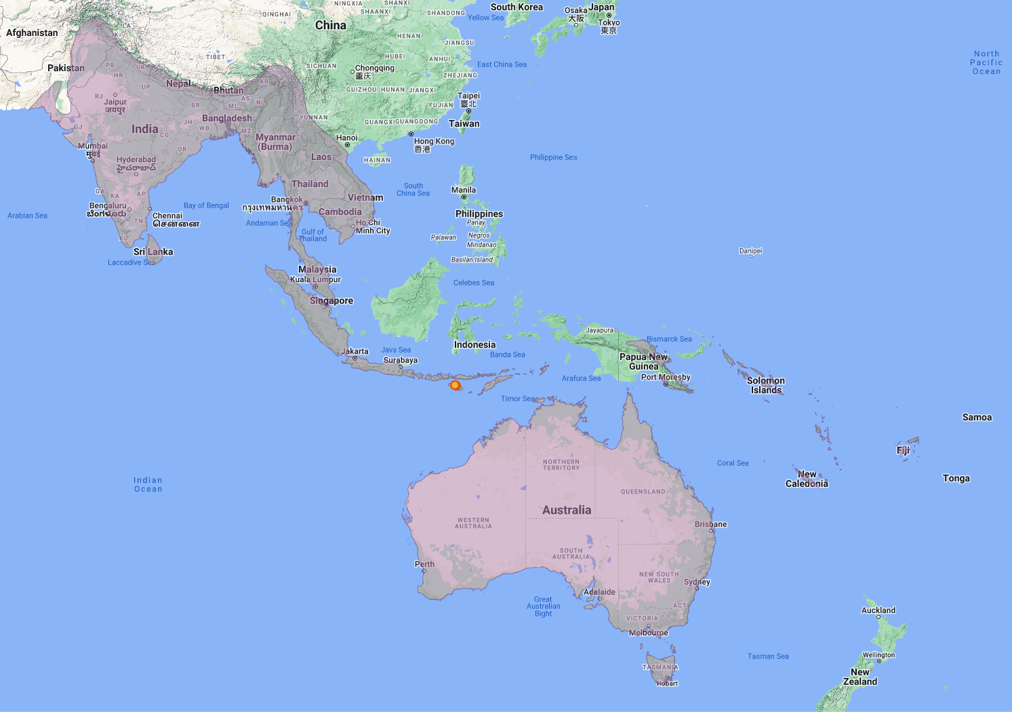
Approximate distribution of the Eastern Barn Owl. © Xeno-Canto 2023
Comprises two potentially distinct forms: the widespread “Eastern Barn Owl” (javanica) and the localized, insular, little-known “Boang Barn Owl” (crassirostris) of the Tanga Islands in the Bismarck Archipelago. The status of crassirostris is unclear due to a lack of published documentation.
Resident essentially throughout the Indian subcontinent west to the Indus River Valley of Pakistan, north to the foothills of the Himalayas, and south to Sri Lanka. Also resident essentially throughout Southeast Asia, mainly in lowlands, north locally or sporadically across the Chinese border into Yunnan, Guangxi, southwesternmost Guangdong, and Hainan, and south to Singapore.
In Indonesia, resident on Sumatra, Java, and the Lesser Sundas from Bali to Timor. Apparently resident locally in northern Borneo (Sabah and adjacent areas) and possibly also in southern Borneo. A rare, localized resident of eastern New Guinea, where most records are from the environs of Port Moresby, with a few scattered reports elsewhere, including the adjacent islands Manam and Karkar.
In Australia, resident essentially throughout the mainland and on some adjacent islands, including Kangaroo Island. Either a rare, localized resident or an occasional visitor to northern Tasmania.
In Melanesia, resident on New Caledonia, the Loyalty Islands, Vanuatu, and the southern Solomon Islands (Guadalcanal, Rennell, and Santa Cruz). In Polynesia, resident on Fiji, Wallis and Futuna, Tonga, Samoa, and Niue.
Starting around 2008, a few individuals have been reported from North Island, New Zealand, mainly around Kaitaia, but also much farther south, possibly indicating the establishment of a new population.
Identification
A medium-sized, pale barn owl, slightly smaller and usually paler than the similar Tyto species that overlap with it. Sometimes recognizable by its narrower, more heart-shaped facial disk.
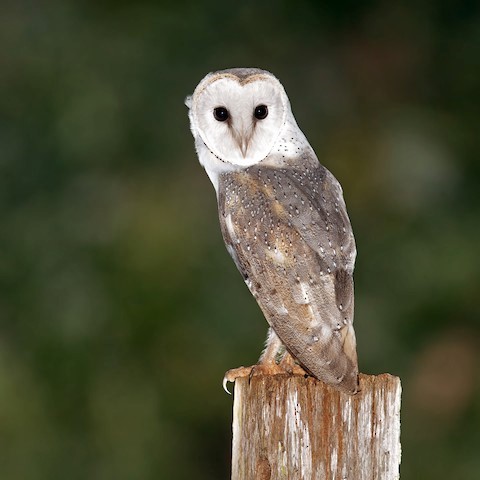
Eastern Barn Owl. (Kairi, Tablelands, Queensland, Australia; January 6, 2020.) © JJ Harrison,
The upperparts are usually blotchy gray-brown and tan with white spots on the wing coverts and back. Some individuals are grayer overall, and others are more brownish or infused with buffy or rusty tones.
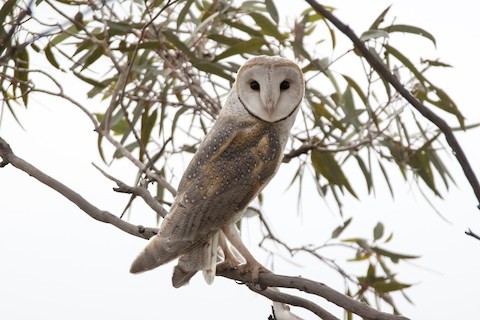
Eastern Barn Owl. (Yarriambiack, Victoria, Australia; July 22, 2020.) © John Cantwell
The underparts are white or buffy with dark spots. Males are smaller and tend to appear all-white below with sparse spotting. Females vary from white to orange-buffy below, and are often densely spotted.
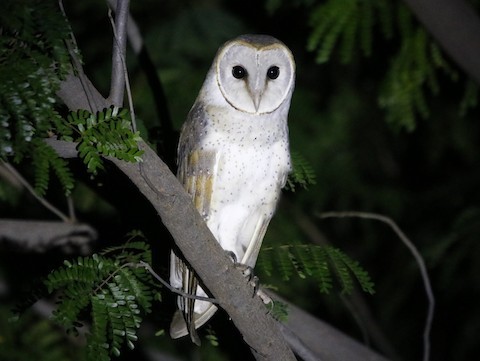
Eastern Barn Owl, typical male with mostly white underparts. (Vekariya, Ahmedabad, Gujarat, India; October 25, 2020.) © Bhaarat Vyas

Eastern Barn Owl, female with relatively dark buffy underparts and rusty upperparts. (Kallara, Kerala, India; March 10, 2023.) © Sree
The facial disk typically appears white or whitish, sometimes grayish or tan, framed by a thin rim that is usually golden-brown above and darker below.
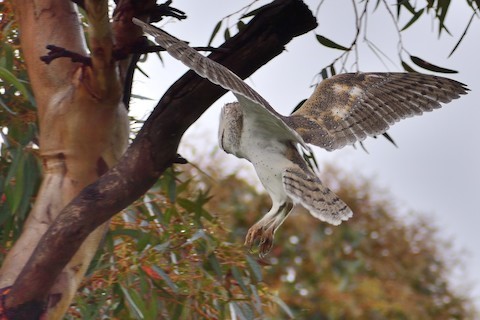
Eastern Barn Owl, showing uppersides of wings and tail. (Royal Park, Melbourne, Victoria, Australia; September 4, 2021.) © Ken Tay
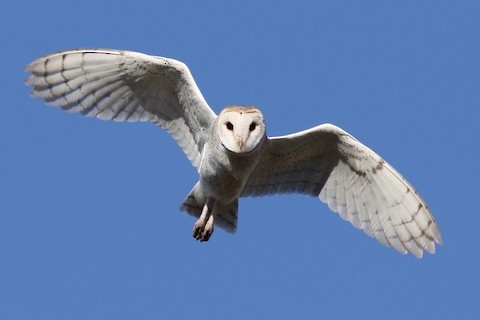
Eastern Barn Owl. (Rupanyup, Yarriambiack, Victoria, Australia; July 2, 2018.) © Leigh Pieterse
“Boang Barn Owl”. A form of barn owl described from the Tanga Islands is reportedly “markedly darker in plumage, stronger talons and a stronger, thicker bill” than the typical, widespread Eastern Barn Owl. (König and Weick 2008) Apparently no photos of this form are publicly available.
Voice. Typical calls include rasps:Harsh screams:And clearer, more plaintive screams:
Notes
Polytypic species consisting of seven recognized subspecies that represent two potentially distinct forms: the “Eastern Barn Owl” (javanica plus five others) and the “Boang Barn Owl” (crassirostris).
Both recent guidebooks to the owls of the world, König and Weick (2008) and Mikkola (2013), treat the “Boang Barn Owl” as a separate species based on reported morphological differences: i.e., stronger talons and a stronger, thicker bill than in other Eastern Barn Owls. Documentation of these differences is not readily available, and it seems inherently dubious that the “Boang” form’s reported range, the Tanga Islands, with less than 60 square kilometers of land, contain enough habitat to sustain an isolated population of barn owls.
Worldwide barn owl taxonomy is unsettled. The Eastern Barn Owl has traditionally been classified together with many other taxa as comprising the cosmopolitan Barn Owl, Tyto alba. Many, if not most, taxonomic authorities maintain this classification. However, the emerging consensus is that the traditional T. alba represents three major lineages that should each be recognized as one or more species: the Western Barn Owl (alba) of western Eurasia and Africa; the Eastern Barn Owl (javanica) of southern Asia and Australasia; and the American Barn Owl (furcata) of the New World.
More Images of the Eastern Barn Owl
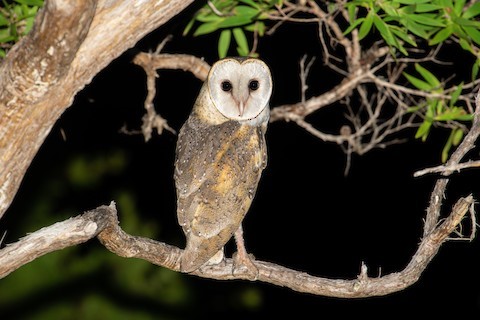
Eastern Barn Owl. (Iron Range National Park, Queensland, Australia; December 22, 2019.) © Louis Backstrom
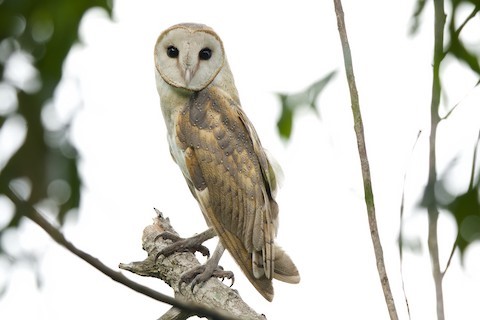
Eastern Barn Owl. (Lam Toi Ting, Nong Chok, Bangkok, Thailand; July 1, 2023.) © Sam Hambly

Eastern Barn Owl. (Royal Park, Melbourne, Victoria, Australia; September 4, 2021.) © Ken Tay
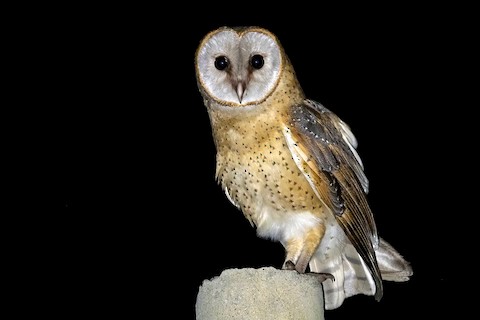
Eastern Barn Owl. (Hainan, China.) © Su Li

Eastern Barn Owl. (Mannar, Sri Lanka; April 21, 2016.) © Sindoopa Seneviratne
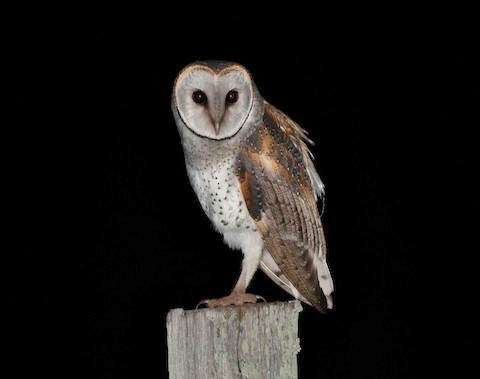
Eastern Barn Owl. (Running Creek, Scenic Rim, Queensland, Australia; May 2, 2021.) © Steven McBride
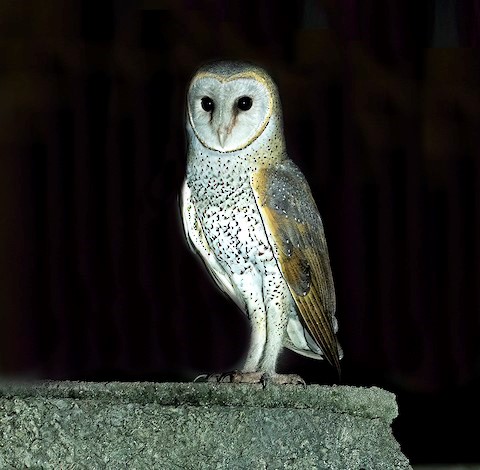
Eastern Barn Owl. (University of Jammu, Jammu, India; August 18, 2022.) © Parmil Kumar
References
Aliabadian, M., N. Alaei-Kakhki, O. Mirshamsi, V. Nijman, and A. Roulin. 2016. Phylogeny, biogeography, and diversification of barn owls (Aves: Strigiformes). Biological Journal of the Linnean Society 119:904-918.
BirdLife International. 2019. Tyto alba (amended version of 2016 assessment). The IUCN Red List of Threatened Species 2019: e.T22688504A155542941. https://dx.doi.org/10.2305/IUCN.UK.2019-3.RLTS.T22688504A155542941.en. (Accessed December 12, 2023.)
eBird. 2023. eBird: An online database of bird distribution and abundance. Cornell Lab of Ornithology, Ithaca, N.Y. http://www.ebird.org. (Accessed December 12, 2023.)
iNaturalist. 2023. https://www.inaturalist.org/. (Accessed December 12, 2023.)
König, C., and F. Weick. 2008. Owls of the World (Second Edition). Yale University Press.
Mikkola, H. 2013. Owls of the World: A Photographic Guide (Second Edition). Firefly Books, London.
Pizzey, G., and F. Knight. 2012. The Field Guide to the Birds of Australia. HarperCollins, New York.
Robson, C. 2002. Birds of Thailand. Princeton University Press.
Treesucon, U. and W. Limparungpatthanakij. 2018. Birds of Thailand. Lynx Edicions, Barcelona.
Xeno-Canto. 2023. Eastern Barn Owl – Tyto javanica. https://xeno-canto.org/species/Tyto-javanica. (Accessed December 12, 2023.)
